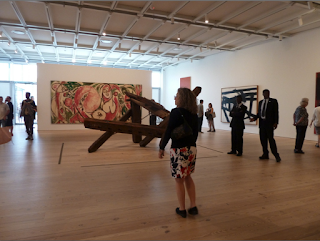 |
| Wall of floral-themed quilts. |
Chilly temps, days with less sun - autumn brings a loss of warmth and light; however, there are compensations, such as the Rising Star quilt guild annual show. On display October 9 and 10, this exhibit was a delight, and some representative quilts are featured below. (Click on any image to enlarge it.)
 |
| Summer in a Pot, Janice Shaw. |
Many quilts explored a floral theme, including a raw-edge applique portrait of geraniums, by Janice Shaw, based on a pattern by
Laundry Basket Quilts.
 |
| Summer in a Pot, detail. |
It's sometimes difficult to utilize the large-scale fabrics which so many of us love, but
Big Poppy succeeds in combing prints in different scales. Artist Bebe Fallick adapted the Big EZ pattern from
Bloom Creek for her work.
 |
| Big Poppy, Bebe Fallick. |
 |
| Large quilts and boutique area in Keilty Hall. |
The quilts were hung in two areas: the basement of St. Brigid's church, in Lexington, Massachusetts, and in nearby Keilty Hall, seen above. In addition to quilts on display, there were vendors, the guild's own boutique of hand-made items - a great resource for early holiday shopping - and, of course, the wonderful bake shop.
Another quilt genre well-represented in the show is the landscape quilt, including Barbara Salamy's delightful original creation below.
 |
| Sea, Sky and Sand Dunes, Barbara Salamy. |
Atara Halpern reflected on the challenging winter of 2014-2015, during which our entire region developed mass cabin fever. Ms. Halpern's quilt - a symphony of applique, beading, and embroidery techniques - showed us coping in our "cabins" by celebrating the holidays and, of course, curling up with good books! Celebrations of color helped us get through "snowmageddon" too. Peter Stringham's quilt, below, is based on a pattern from the book
"Strip Quilting" by Diane Wold. For her colorful quilt
Love Wins 2015, Kathleen McCormick utilized the pattern "Prism Quilt" by
Nancy Rink.
 |
| December in New England, Atara Halpern. |
 |
| December in New England, details. |
 |
| Autumn Orchard, Peter Stringham. |
 |
| Love Wins 2015, Kathleen McCormick. |
 |
| Love Wins 2015, detail. |
Quilts can have an impact with a limited color palette too, as demonstrated in the modern quilts below. The quilt by Missy Shay continues the venerable tradition of red and white quilts, and is based on the pattern "Diamond Alley" by
Sassafras Lane Designs; a nice detail of this work is the pieced binding.
For the quilt commemorating her daughter's wedding anniversary, Pat Fryzel combined blocks won in a guild auction. And in the third quilt below,
Modern Sunset, the traditional T-square block becomes contemporary, based on a pattern by
Kimberly Einmo, and
beautifully machine-quilted by Sue Ahnrud.
 |
| Red and White, Missy Shay. |
 |
| Happy Third Anniversary, Pat Fryzel. |
 |
| Modern Sunset, Carolyn Bell. |
While the modern quilts rely primarily on solids or geometric prints, my beloved plaids were on view too, in a beautiful string-style quilt by Nancy Soyring. Melissa Radzyminski has combined a plaid fabric and prints in a quilt which, in the best tradition of the medium, makes a useful, lovely object from materials at hand, as the quilt is composed of nine-patch blocks leftover from other projects, and a plaid that was a fortuitous gift. I love the way the plaids are a tad charmingly askew.
 |
| Plaid X, Nancy Soyring. |
 |
| Plaid X, detail. |
 |
| Plaid and 4-Patches, Melissa Radzyminski. |
 |
| Plaid and 4-Patches, detail. |
One of the highlights of the show was a fun, educational display illustrating the History of Quilting, master-minded by Nancy Howard and Julie Neu. Brief text described, concisely yet comprehensively, each major phase of quilt-making in America, with accompanying small stitched examples.
 |
| Quilts illustrating phases of quilt-making in America. |
The contributions of quilters of color were acknowledged, with a rare example of a 19th-century menswear pieced quilt, in the Box Cars pattern and utilizing suiting fabrics, shown below.
According to the label information, supplied by quilt owner Delores McCravy:
This Antique quilt was owned by Mrs. Thelma Tate (1905-1998) a long time family friend. She was born and lived in Rogersville, Hawkins County, Tenn. Mrs. Tate inherited the quilt, along with a larger one, from her grandmother Louise Porter (1847) who made them. My sister purchased the quilts at a yard sale held, after her death, by her son and daughter-in-law.
So, this quilt has made quite a journey, from rural Tennessee to suburban Boston.
Finally, a detail of a miniature Baltimore Album quilt, illustrating this genre, by master quilter Nancy Howard. The block is approximately 3" square, but loaded with expertly designed and stitched detail, not to mention charm.
























































